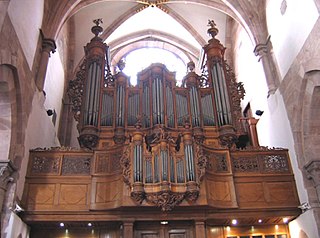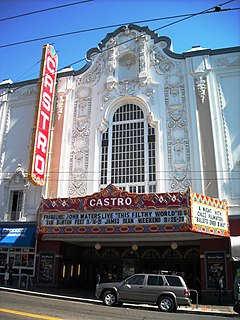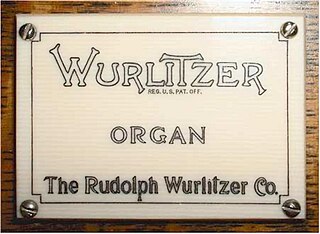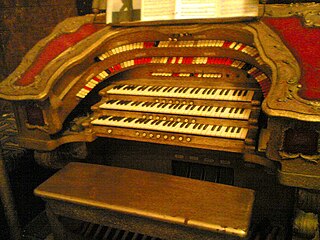
The pipe organ is a musical instrument that produces sound by driving pressurized air through the organ pipes selected from a keyboard. Because each pipe produces a single pitch, the pipes are provided in sets called ranks, each of which has a common timbre and volume throughout the keyboard compass. Most organs have many ranks of pipes of differing timbre, pitch, and volume that the player can employ singly or in combination through the use of controls called stops.

In music, the organ is a keyboard instrument of one or more pipe divisions or other means for producing tones, each played with its own keyboard, played either with the hands on a keyboard or with the feet using pedals.

The Castro Theatre is a historic movie palace in San Francisco that became San Francisco Historic Landmark #100 in September 1976. Located at 429 Castro Street in the Castro District, it was built in 1922 with a California Churrigueresque façade that pays homage—in its great arched central window surmounted by a scrolling pediment framing a niche—to the basilica of Mission Dolores nearby. Its designer, Timothy L. Pflueger, also designed Oakland's Paramount Theater and other movie theaters in California during that period. The theater has over 1,400 seats. The theater's ceiling is the last known leatherette ceiling in the United States and possibly the world. Another leatherette ceiling was demolished just a few years ago. To make the ceiling look as though it is leather requires a special technique regarded as lost today.

An electric organ, also known as electronic organ, is an electronic keyboard instrument which was derived from the harmonium, pipe organ and theatre organ. Originally designed to imitate their sound, or orchestral sounds, it has since developed into several types of instruments:

A pedalboard is a keyboard played with the feet that is usually used to produce the low-pitched bass line of a piece of music. A pedalboard has long, narrow lever-style keys laid out in the same semitone scalar pattern as a manual keyboard, with longer keys for C, D, E, F, G, A and B, and shorter, raised keys for C♯, D♯, F♯, G♯ and A♯. Training in pedal technique is part of standard organ pedagogy in church music and art music.

A theatre organ is a distinct type of pipe organ originally developed to provide music and sound effects to accompany silent films during the first 3 decades of the 20th century.

The Rudolph Wurlitzer Company, usually referred to as simply Wurlitzer, is an American company started in Cincinnati in 1853 by German immigrant (Franz) Rudolph Wurlitzer. The company initially imported stringed, woodwind and brass instruments from Germany for resale in the United States. Wurlitzer enjoyed initial success, largely due to defense contracts to provide musical instruments to the U.S. military. In 1880, the company began manufacturing pianos and eventually relocated to North Tonawanda, New York. It quickly expanded to make band organs, orchestrions, player pianos and pipe or theatre organs popular in theatres during the days of silent movies.

A manual is a musical keyboard designed to be played with the hands, on an instrument such as a pipe organ, harpsichord, clavichord, electronic organ, melodica, or synthesizer. The term "manual" is used with regard to any hand keyboard on these instruments to distinguish it from the pedalboard, which is a keyboard that the organist plays with their feet. It is proper to use "manual" rather than "keyboard", then, when referring to the hand keyboards on any instrument that has a pedalboard.

The Michigan Theater is a movie palace in Ann Arbor, Michigan, United States. It shows independent films and stage productions, and hosts musical concerts.

The Byrd Theatre is a cinema in the Carytown neighborhood of Richmond, Virginia. It was named after William Byrd II, the founder of the city. The theater opened on December 24, 1928 to much excitement and is affectionately referred to as "Richmond’s Movie Palace". It was the first cinema in Virginia to be outfitted when built with a sound system.
An organ recital is a concert at which music specially written for the organ is played.
George Wright was an American musician, possibly the most famous virtuoso of the theatre organ of the modern era.

The Bartola Musical Instrument Company of Oshkosh, Wisconsin, USA, was a producer of theater pipe organs during the age of silent movies.

The Paramount Theatre is a concert venue in Denver, Colorado, located on Glenarm Place, near Denver's famous 16th Street Mall. The venue has a seating capacity of 1,870 but is a popular destination for large acts looking for a smaller concert setting. With spelling as Paramount Theater, the building was listed on the National Register of Historic Places in 1980.

The Riviera Theatre is a historic, 1140 seat entertainment venue in North Tonawanda, New York. The theatre hosts a multitude of performing arts events per year, including live concerts, theatre, dance shows, and movies. The Riviera's “Mighty Wurlitzer” theatre organ has been fully restored, is continually maintained by volunteers, and is famed as being one of two original Wurlitzer demonstrator organs, which the company would use to show off to potential clients in the height of the silent film era.

The pipe organ is played from an area called the console or keydesk, which holds the manuals (keyboards), pedals, and stop controls. In electric-action organs, the console is often movable. This allows for greater flexibility in placement of the console for various activities. Some very large organs, such as the van den Heuvel organ at the Church of St. Eustache in Paris, have more than one console, enabling the organ to be played from several locations depending on the nature of the performance.
Registration is the technique of choosing and combining the stops of a pipe organ in order to produce a particular sound. Registration can also refer to a particular combination of stops, which may be recalled through combination action. The registration chosen for a particular piece will be determined by a number of factors, including the composer's indications, the time and place in which the piece was composed, the organ the piece is played upon, and the acoustic environment within which the organ resides.
The Organ Grinder Restaurant was a Portland, Oregon pizzeria in operation from 1973 to 1996. At one point it housed the largest theater pipe organ of its type in the world.

David Howard Hegarty is an American organist and composer. He has served as organist at the Castro Theatre in San Francisco since 1978.
Dan Bellomy was an American organist who performed on pipe and electric organs. Bellomy's theater organ performances were acclaimed for their inclusion of the jazz idiom, and he was at times described as a pure jazz organist. He wrote scripts for and directed several local television shows.

















